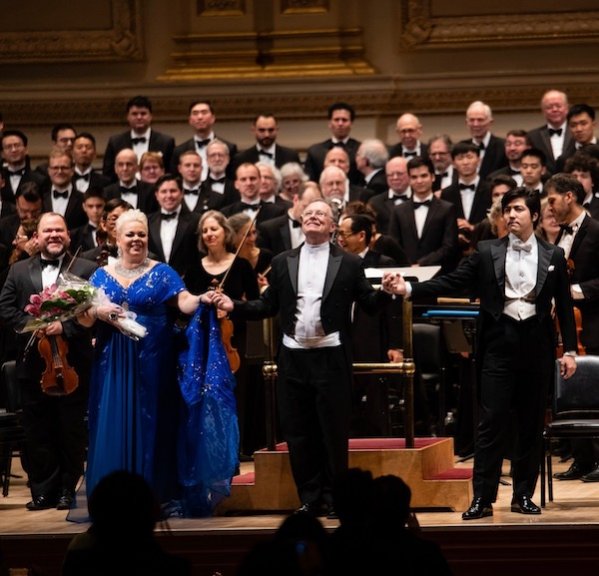Slack orchestra, uneven conducting make for mixed rewards from Oratorio Society

Soloists Johanna Rusanen and Takaoki Onishi with Kent Tritle and the Oratorio Society of New York acknowledge applause following Monday night’s performance of Sibelius’s “Kullervo” at Carnegie Hall. Photo: Anna Yatskevich
Berlioz, Debussy, and Sibelius together wrote some of the most colorful and individual music in the classical repertoire. The distinctive sound they each produced evokes powerful, non-musical images and sensations—Berlioz’s dreamlike narratives, the paintings of Monet and Whistler for Debussy, the massive, timeless strength of the earth in Sibelius’ sonic landscapes.
It may seem impossible to take such material and turn it into a bland, anodyne experience. That was the unfortunate case with Monday night’s concert from the Oratorio Society of New York at Carnegie Hall. The chorus, orchestra, and conductors David Rosenmeyer and Kent Tritle, played orchestral excerpts from Berlioz and Debussy, and Sibelius Kullervo, and the experience was mainly a mix of dull and baffling.
Baffling in that “La mort d’Ophélie” from Berlioz’ Tristia and the “Sirènes” movement of Debussy’s Nocturnes could ever be made to sound dull. These two were played for the first half of the concert, with the women of the Oratorio Society Chorus singing and Rosenmeyer and Tritle conducting, respectively.
The chorus had a glistening, cold sound—not unpleasant, like water on steel. They sang Shakespeare’s adapted words with tenderness but with a penumbra of sound that sat in an ambivalent region between a warm, expressive mass and mere imprecision.
The orchestral playing was middling, a presage to the whole concert. The notes were there but there was little polish and no expressive commitment—there was never a sense that there was a reason the orchestra was playing this music.
The lack of energy is something that comes from the top down. While one could not see Rosenmeyer’s face, one could not sense any dynamism in his posture and gestures at the podium.
Nothing changed when Tritle took the stand for the Debussy. Though his gestures were broader and pointed toward more details, he and the orchestra seemed detached from each other, his conducting a set of instructions but no showing much leadership or inspiration. His attention seemed focused on the chorus, which had the right amount of clarity and delicacy, but the orchestra was a grey, thick mass without any of Debussy’s luminosity or strength.
Kullervo fared better, but the responsibility for that came primarily from the men of the Manhattan School of Music Symphonic Chorus, and the soloists: mezzo Johanna Rusanen singing the women characters and baritone Takaoki Onishi a crisp and forceful Kullervo.
Again, the orchestra was heavy and sounded disinterested during the first two movements. In the second movement, which describes Kullervo’s youth, there is a series of resonant climaxes in the middle, plangent brass fanfares through which Sibelius’ aesthetic values inevitably show themselves. But this is followed by quieter music that expresses the composer’s physical and spiritual connection with a Finnish landscape, and that spirit was missing.
So too with the music at the close of the movement. This is soft and tender, it calls for the feeling that the orchestra is handling something warm, precious, and beloved, like a baby; that in turn calls for some style in the playing, a certain weight to the bowing, subtle variations in dynamics and accents in the shape of a phase. None of that was there.
Every time the chorus sang, though, they injected energy into the performance and that spurred the orchestra on for a time. Their rhythms were stiff—compared to the Finn Rusanen’s fluid, expressive way with a line they tiptoed through articulating the language—but they had a passion that produced some musical meaning.
This was enough to bring the battle and death sequences to a respectable close, and made Kullervo at least a demonstration of the piece’s grand possibilities, which were only fitfully met.
The Oratorio Society of New York performs Verdi’s Requiem, 8 p.m. May 9, in Carnegie Hall. oratoriosocietyofny.org



Posted Feb 28, 2019 at 5:34 pm by Richard J Schager Jr
I may have left a message already but not familiar with this site, and feel so strongly about this second rate review that I’m repeating it. No one bought a ticket to this performance expecting to hear the Metropolitan Opera and Chorus. This was an adventurous and integrated program with music that expanded the listeners’ aural horizons, not the oft-repeated pieces that could be played without score. Kudos to Tritle and these fine musicians for having the courage to take it on. The reviewer should return to his comfort zone at Lincoln Center and hear Verdi or Bizet or Puccini for the nth time in his life.